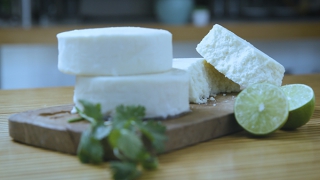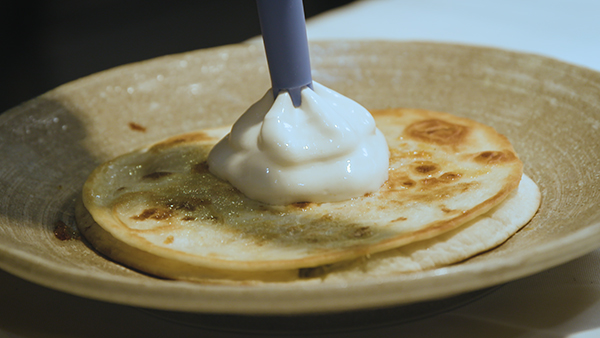
Versatile and Authentic Hispanic-style Cheeses
28 February 2018Hispanic-style cheeses are distinctive in applications from a reverse quesadilla to umami popcorn.
By Real California Milk
Hispanic-style cheeses and cremas add authentic flavor to recipes with Latin flavor profiles. But, don’t stop there. Chefs can also go beyond the basics by including fresh and aged Hispanic-style cheeses in everyday applications too. Cost effective and widely available, Hispanic-style cheese varieties include fresh and aged with flavors that vary from very mild to strong, with salty, spicy and nutty nuances. California is the country’s leading producer of Hispanic-style cheeses, producing more than 25 varieties.
Hispanic-style cheeses fall into two general categories: fresh and aged.
Fresh Cheeses
Fresh, or unripened, cheeses are very young cheeses that have not been allowed to age. Typically, the fresh Hispanic-style cheeses are soft and moist, white or off-white in color and feature the delicious flavor of fresh milk. They have a shorter shelf life than aged cheeses and carry a freshness date on the package. A special characteristic is that they hold their shape during cooking. When heated, typically they soften but do not melt or flow. The following are descriptions of several popular fresh Hispanic-style cheeses, or queso, widely available in California:
| Oaxaca | Mild | White | Semi-firm | Hispanic-style cheese similar to Mozzarella but with distinctive braided appearance. Use as is, in sandwiches, or melted on cooked foods, including pizza and nachos. |
| Panela | Mild | White | Firm, moist | Hispanic-style cheese with flavor similar to a dry pressed Ricotta. Softens but does not melt when heated. Use in sandwiches, salads, with fruit and in cooked foods. |
| Queso Blanco Fresco, Queso Para Frier, or Queso Fresco | Mild | White | Soft, moist, firm | Most commonly used Hispanic-style cheese with a texture that softens but does not melt when heated. Use as a topping or filling in cooked dishes. Also great crumbled onto fruit, beans, salads and other dishes. Commonly refered to as Queso Para Frier when sold as a frying cheese. |
| Requeson | Very mild, semisweet | White | Soft, moist, grainy | Hispanic version of Ricotta that is used in salads, dips, cooked foods and desserts. |
Aged Cheeses
California cheesemakers produce several aged, semi-firm and firm Hispanic-style cheeses. A few of these will soften but not melt or flow when heated or used in cooked dishes. Others are excellent melting cheeses noted for the rich, creamy taste and texture they add to cooked foods. The aged cheeses can be stored in the refrigerator much longer than the fresh varieties. Chefs should handle and store them much like Jack or Cheddar, or like Dry Jack in the case of the very dry types.
There is a style of Hispanic cheese commonly called “añejo” (or “aged”) which is different from its “aged” European and American counterparts. While cheeses in this category are aged to some degree, their characteristic dry texture and pungent, sharp flavor comes from being salted, pressed and dried rather than being “aged” for a long time. The following are some popular aged cheeses that are widely available in California:
| Asadero | Mild | White | Firm | Hispanic-style cheese similar to Provolone in its slightly tangy taste and firm texture. Made with whole or low-fat milk, it melts well and is used in such dishes as quesadillas and nachos as well as hamburgers and sandwiches. |
| Cotija (Queso Anejo) | Strong, aged flavor | White | Hard, dry, crumbly | Hispanic-style cheese typically shredded onto cooked foods, also in salads and with fruit. |
| Cotija | Salty, pungent | White | Semi-firm to firm, crumbly | Hispanic-style cheese similar to Feta. Crumble and sprinkle over cooked dishes, soups, beans and salads. Also called Queso Anejo (aged cheese). Some types may be very dry and hard. |
| Enchilado | Aged, slightly spicy coating | Red spice coating, white interior | Firm, dry, crumbly | Slightly aged Hispanic-style cheese with mild red chili or paprika coating. When aged longer (Anejo-style) may be quite hard. Heated, it softens but does not melt. Crumble onto Mexican foods, soups and salads. |
| Enchilado Anejo | Mild, lightly spicy | Red coating, white interior | Hard, dry, crumbly | Aged version (Anejo) of Enchilado. Good as a topping crumbled onto cooked foods. Softens but does not melt under heat. |
| Menonita | Mild | White | Smooth, semi-firm | Hispanic-style cheese similar in taste and uses to Gruyere or Gouda. |
| Manchego | Mellow, nutty | White | Semi-firm to firm |
This California interpretation of a traditional Spanish cheese uses cows’ milk to create a tasty table cheese. Eaten as is or in sandwiches. Melts well when used for cooking. |
Hispanic-style cheeses and cremas add authentic flavor to recipes with Latin flavor profiles. But it doesn’t stop there. Chef instructors can count on these delicious, hard-working dairy products to add flavor and value across many applications. Here are a few substitution ideas:
| Traditional style cheese | Hispanic-style substitute |
| Jack or Cheddar | Queso Quesadilla or Queso Blanco |
| Cheese crumbles | Queso Blanco Fresco |
| Farmers cheese or Feta | Queso Fresco |
| Fresh Mozzarella | Oaxaca |
| Part-skim Mozzarella | Panela |
| Ricotta | Requeson |
| Provolone | Asadero |
| Parmesan or Dry Jack | Queso Anejo or Cotija |
| Gouda | Menonita |
Instructors can choose to use Hispanic-style dairy products in unusual applications, such as:
- For a mild flavor, add Queso Fresco to omelets or egg scrambles. The texture will soften, without melting.
- Serve a seasonal watermelon and heirloom tomato salad with a Queso Fresco in lieu of Feta.
- Sprinkle Cotija cheese on popcorn for a snack with extra umami.
- Fry Panela cheese on the griddle for a caramelized color with a soft texture. Add it to any stir-fry for a unique flavor combination.
- Try Oaxaca as pizza cheese for added flavor.
The Unconventionally Familiar
California Milk Advisory Board’s (CMAB) REAL Makers chef Ahktar Nawab of Alta Calidad in Brooklyn, New York, loves to surprise people with unique and interesting twists on classic techniques using real California Hispanic-style dairy. “I love turning traditional Mexican dishes inside out,” he says, and his Pumpkin Blossom Reverse Quesadilla is no different.
 “What makes this quesadilla different is the espuma; a creamy cheese foam made with California Queso Oaxaca and Crema that melts over the surface. We finish it with a house-made Ancho chili-charcoal ash. We love to find original takes, or creative ways to introduce our cuisine to a broader group of people.”
“What makes this quesadilla different is the espuma; a creamy cheese foam made with California Queso Oaxaca and Crema that melts over the surface. We finish it with a house-made Ancho chili-charcoal ash. We love to find original takes, or creative ways to introduce our cuisine to a broader group of people.”
CMAB’s REAL Makers campaign features a series of videos that salute innovative chefs who design their culinary creations with the best ingredients and the greatest respect for the food. They have a maker spirit in how they approach food: hands-on craftsmanship and dedication to the highest standards of the culinary arts. And REAL California dairy is an integral part of their professional life. Watch Chef Akhtar’s video at www.RealCaliforniaMilk.com/foodservice.
Photos courtesy of The California Milk Advisory Board (Real California Milk).
About: The California Milk Advisory Board (Real California Milk), an instrumentality of the California Department of Food and Agriculture, is funded by the state’s more than 1,300 dairy farm families. With headquarters in Tracy, the CMAB is one of the largest agricultural marketing boards in the United States. For more ideas, recipes, and information on how to source California dairy products, visit www.RealCaliforniaMilk.com/foodservice.
